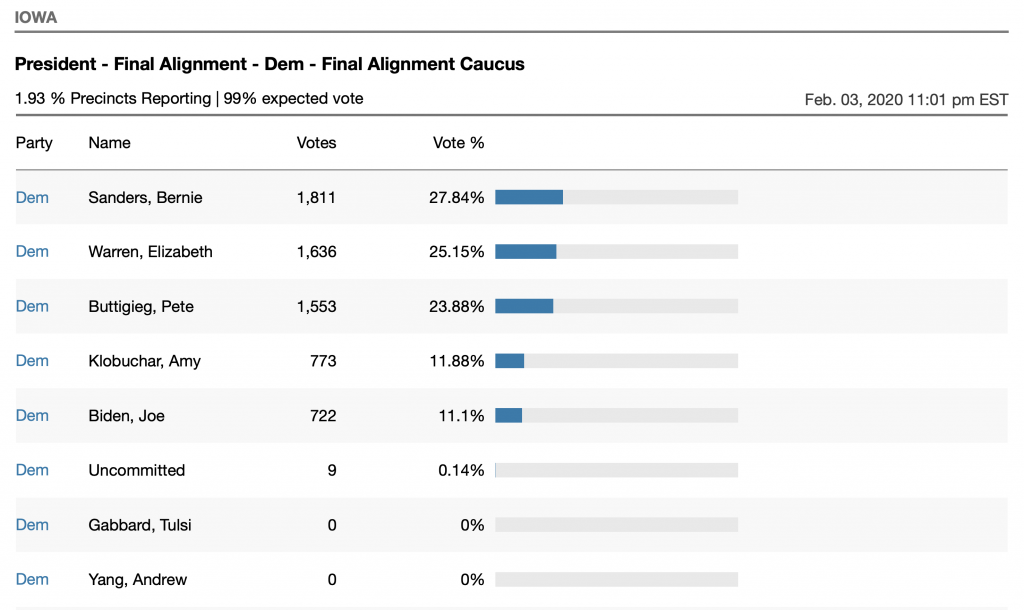As huge crowds of supporters gathered to hear speeches from their favorite candidates on Caucus night in Iowa, the candidates were unable to tell their supporters the one thing everyone wanted to know: Who won.
Based on totals received from their precinct captains and other campaign workers, Amy Klobuchar, Elizabeth Warren, Pete Buttigieg, and Bernie Sanders all knew they had done well, and could probably determine the outcome for the top positions, but without all the official votes counted, they wouldn’t likely make any specific statement based on their own data. If their data was off, or even if it wasn’t, such an announcement could be criticized. The actual outcome would need to be determined by people’s votes, tallied by the Democratic Party, and announced through official news media outlets. But it soon became clear that such an announcement was going to be delayed, leaving many people frustrated.
On the evening of the Iowa Caucus, the Sanders campaign released what seemed to be reliable caucus results based on realtime reporting from their precinct captains. While Bernie didn’t specifically come out and say “We won in Iowa!” the data pointed to that conclusion. In doing this, Bernie proved that his team was able to deliver what the Democratic Party had not. The results that everyone was waiting for. This was a double-win for the Sanders campaign.
Some would criticize the Sanders campaign, claiming that the announcement was self-serving and only based on 40% of the data. Yet, ultimately, having some fairly accurate data from a leading well-organized campaign helped alleviate some stress and uncertainty for everyone. It also showed that establishment Democrats like Joe Biden and billionaires like Tom Steyer were not coming out in the lead.

Presumably the other candidates had a very similar table of results, but it’s understandable that the actual winner will be the one motivated to release that data. Seven other candidates were less motivated to have the results announced if they hadn’t won.
Pete Buttigieg was criticized for giving a ‘victory speech’ to his supporters the evening of the Iowa Caucus by opponents who said he had zero data to make such a claim.
At 1:01 AM on 4 Feb 2020, Joe Rospars, a strategist with the Warren campaign, took a shot at Buttigieg on Twitter: “Any campaign saying they won or putting out incomplete numbers is contributing to the chaos and misinformation.” [source]
By 1:33 AM on 4 Feb 2020, Business Insider published this article: “Pete Buttigieg declares victory in the Iowa caucuses with zero percent of the vote in.” [source]
So, the headlines moved from “incomplete numbers” to “zero percent of the vote” in a phenomenon known as headline creep – where story headlines increasingly become more sensationalized and misleading over time in an effort to get clicks and shares.
What Mayor Pete actually announced was the following:
“We don’t know ALL the results, but we know when it’s all said and done, Iowa, you have shocked the nation. Because by all indications, we are going on to New Hampshire victorious.”
Below is a video of what Mayor Pete actually said. He acknowledged that all the data wasn’t in, and he didn’t flat out say “We Won!” but that it looked like they would be victorious.
How could Buttigieg make such a claim? Well, as stated previously, all the candidates had their own people collecting data from the precincts. So the sizable amount of data internally available to the Buttigieg campaign pointed to a win. In addition to their own internal data, there was some data trickling in from the Associated Press. Below is what was being reported at 9:53 PM CT.

It’s possible that someone in the Buttigieg campaign looking at their own internal data, and looking at the early data from AP, could conclude they were in the lead.
A person could look at the chart above, and assume that several thousand results would be random enough to predict the outcome, but they would be mistaken. A short time later, Sanders moved into the lead simply from another .1% of the data coming in as can be seen below.

Regardless of who is in which of the top four positions, all of the top four candidates can declare a “victory” for having been on top in Iowa which will garner them more mentions in the news and more funding as they are perceived to be viable candidates going forward.
So, it’s not about giving out participation awards and declaring everyone is a winner, but those in the lead coming out of the Iowa Caucus are all treated like winners moving forward, and they should be.
With more of the data we see a clearer picture of the Caucus results as shown below.

In competitive sports like the Olympics, fractions of seconds make a difference between winning and losing. We tend to think the same way about politics. Yet, campaigning is like watching a horse race in slow motion over many months. At any one moment you might think one candidate is ‘winning’ but the positions are continuously changing. Polls and voting data help as indicators, but they fluctuate.
Rather than announcing victory, the Bernieesque approach to this situation will undoubtedly be more appealing to many voters… “We’ve gathered 40% of the data from 100% of the precincts and aggregated that data to come up with the following table with figures based on the information we have so far.” I’ll leave it up to you to imagine Stephen Colbert’s imitation of Bernie Sanders saying these things, but when we’re dealing with educated voters who like transparency and facts, the type of approach Bernie used will always be popular.
Below is a CBS report from 5 Feb 2020 at about 8:00 AM CT.
